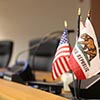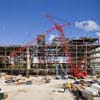FCC Threatens Public Agencies' Local Control Over Next-Gen Cellular Deployment

November 2018
Number 76
In anticipation of the wave of next-generation cellular technology, the Federal Communications Commission (FCC) adopted a Declaratory Ruling and Third Report and Order significantly preempting state and local control over the use of public rights of way for the deployment of "small wireless facilities" (i.e., micro cellular antennas and equipment). The preemption order was published in the Federal Register on October 15, 2018, and will become effective on January 14, 2019, unless a petition for reconsideration or judicial review is filed. The FCC's preemption has broad-ranging impacts on local jurisdictions' ability to impose both application and recurring fees. It also dramatically reduces timeframes for application review (especially for multi-site applications), and places important restrictions on aesthetic and historical preservation regulations. Although the FCC does not directly address school districts or county offices of education - agencies that often site cell towers on their properties - failure of these entities to abide the FCC's new state and local restrictions would likely invite the FCC to extend its preemption to these entities in the future, especially where the school agency has already established facilities.
Scope of Preemption
From 2006 to 2016, the wireless industry constructed approximately 308,000 "macro cell sites" across the country. Macro cell sites use technology that allows the cellular signal to traverse long distances, so the cell towers can be located hundreds of feet, if not miles, apart. Due to the exponentially fast-growing demand for wireless services, the need to ensure adequate bandwidth to accommodate that demand is compelling the wireless industry to "densify" cellular networks using fifth-generation (5G) ultra-high-frequency wave technology. Because the signals do not travel as far, 5G deployment will require many more "small cell" facilities than previously constructed.
In comments to the FCC, wireless carriers estimated they will need to construct at least 3 to 10 small cells for every macro cell previously built. Taken in the aggregate, some carriers estimate that the industry will need to construct hundreds of thousands of small cell facilities, more than doubling the number of macro cells that were constructed nationwide in the last decade. To put that in context, imagine processing 3 to 10 times the number of cell siting applications your agency processed in the last decade with significantly lower review and attachment fees, and doing it in much shorter timeframes.
The overall objective of the FCC's preemption order is to restrict state and local measures that "materially inhibit" small cell facilities deployment. The FCC has concluded that states and cities have several regulatory tools they use to "materially inhibit" such deployment: purportedly unreasonable application fees, supposedly excessive recurring fees for access to or pole attachments in the public rights of way, lengthy review times, and onerous zoning and permitting requirements, which include, but are not limited to, minimum-spacing requirements between cells, undergrounding requirements, and ambiguous aesthetics review and regulation. The FCC addressed each of these types of regulations.
Application Review and Recurring Attachment Fees
The FCC's order unambiguously preempts some state and local fees and creates "safe harbors" for others so long as they are set below "presumptively reasonable" rates. The FCC determined, for instance, that "per-facility fees" - as opposed to per-application fees for applications that propose multiple sites - are "effective prohibitions" on deployment that are now preempted. Similarly, "gross revenue fees" for occupying public rights of way (such as requiring the carrier to pay five percent of gross revenues derived from the site) are also preempted.
Although the FCC acknowledged that local jurisdictions may have unique community needs and that one fee structure will not meet the needs of all agencies, it established a framework for determining whether an agency's fees are legal (i.e., if the fees do not meet all of these conditions, they are deemed illegal). That framework requires that the fees:
The FCC did not find it necessary to set a particular accounting or costing method for determining whether particular fees meet these criteria, but it will hold local agencies to these criteria.
As an alternative, the FCC established that, if a jurisdiction was to charges fees equal to or lower than a certain threshold, it would constitute a "safe harbor" against any legal challenges of reasonableness. The "safe harbor" would cover fees that are equal to or lower than:
In 2009, the FCC established what are called "Shot Clocks," which are "presumptively reasonable periods" for local agency review of and action on a proposed wireless facility application. Those Shot Clocks allowed 90 days for review of applications proposing to collocate wireless equipment on existing poles with other equipment attachments, and 150 days for reviewing new siting applications. If an agency did not act within the Shot Clock period, that inaction was deemed a "failure to act" and the carrier could seek legal redress immediately in the courts.
In its preemption order, the FCC shortened the Shot Clocks for small wireless facilities applications while increasing the ease with which the carrier can secure injunctive relief directing the local agency to issue the permits if the agency "fails to act" timely. Specifically, the FCC reduced the application processing times from 90 to 60 days for applications proposing to collocate on existing poles, and from 150 to 90 days for reviewing new siting applications. In addition, the FCC stated that, not only would the carrier have the same access to court redress for an agency's failure to act within the Shot Clock deadline, but the inaction is now defined as a "presumptive prohibition" against deployment, which allows for expeditious granting of injunctive relief directing the issuance of the permit(s).
Where this shortened review period becomes especially challenging at the local level is when carriers "batch" applications for processing. "Batched applications" involve two scenarios where a single application proposes multiple sites, or multiple applications for single sites are filed at the same time. Regardless of the number of sites proposed in batched applications, the Shot Clock deadlines remain the same: 60 days for collocated facilities and 90 days for new siting. The FCC's reasoning is that, even if each siting application was filed separately but simultaneously, the deadlines would be the same for processing regardless. The only allowable exception would be where the local agency can show that the batch of applications resulted in a "legitimate overload on the agency's resources."
In addition, the local jurisdiction should be aware that the review period begins on the day the application is submitted, regardless of whether it is later deemed to be incomplete. If the local agency notifies the applicant within 30 days of the initial submission that the application is incomplete, the Shot Clock is paused until the carrier submits the necessary supplemental information. If the application is still incomplete after the supplemental filing, the local agency must notify the applicant within 10 days of the supplemental submission, at which point the Shot Clock will be tolled again. The FCC order does anticipate that these restrictive provisions will apply unless the agency and the carrier agree to a different tolling arrangement.
Other, Non-Fee Land Use Requirements
As noted above, local agencies have many cell siting concerns that are unrelated to siting application fees and processing times. These concerns include aesthetic considerations - like avoiding unsightly overhead clutter - undergrounding of facilities, and historical preservation. First, the FCC ordered that any local requirement that all small wireless facilities must be undergrounded is an effective prohibition against deployment and is, therefore, preempted. All other non-fee land use requirements will be evaluated regarding whether they "materially inhibit" deployment. The only "safe harbor" for non-fee land use requirements is where they (1) preserve and advance "Universal Service," (2) protect public safety and welfare, (3) ensure the quality of telecommunications service(s), or (4) safeguard consumer rights. To the extent a community wishes to maintain aesthetic review of these applications, it must clearly articulate the criteria by which the application will be judged, and it must publish those criteria in advance of an application being filed.
Non-Discriminatory Treatment
The FCC also prohibited discriminatory treatment between different types of right-of-way users, including macro cell versus small cell facilities. The FCC set out two types of discriminatory treatment that it specifically prohibits. First, a local agency may not charge new entrants right-of-way fees that it does not charge incumbent users. Second, the range of fees charged to one type of user (e.g., small wireless facilities users) cannot deviate significantly from the range of fees charged to other users with similar right-of-way uses (e.g., utility users versus small cell users). These non-discrimination concerns apply to both one-time, non-recurring charges and to recurring use fees.
Takeaways
All local agencies that regulate land use for cell siting, including counties, cities, and school districts that already have cell towers, must reevaluate their siting practices to conform to the FCC's preemption order or face the further loss of local control over the public rights of way. Our team of land use and technology attorneys can assist with your review and update of siting practices to include development of a "safe harbor" fee structure, establishing process times that meet or beat the "Shot Clock," tolling agreements that may relieve some of the Shot Clock pressure, and aesthetic review criteria that will withstand legal scrutiny.
For more information on the FCC's action or for land-use or cellular facilities questions generally, please contact the authors of this Client News Brief or an attorney at one of our eight offices located statewide. You can also visit our website, follow us on Facebook or Twitter or download our Client News Brief App.
Number 76
In anticipation of the wave of next-generation cellular technology, the Federal Communications Commission (FCC) adopted a Declaratory Ruling and Third Report and Order significantly preempting state and local control over the use of public rights of way for the deployment of "small wireless facilities" (i.e., micro cellular antennas and equipment). The preemption order was published in the Federal Register on October 15, 2018, and will become effective on January 14, 2019, unless a petition for reconsideration or judicial review is filed. The FCC's preemption has broad-ranging impacts on local jurisdictions' ability to impose both application and recurring fees. It also dramatically reduces timeframes for application review (especially for multi-site applications), and places important restrictions on aesthetic and historical preservation regulations. Although the FCC does not directly address school districts or county offices of education - agencies that often site cell towers on their properties - failure of these entities to abide the FCC's new state and local restrictions would likely invite the FCC to extend its preemption to these entities in the future, especially where the school agency has already established facilities.
Scope of Preemption
From 2006 to 2016, the wireless industry constructed approximately 308,000 "macro cell sites" across the country. Macro cell sites use technology that allows the cellular signal to traverse long distances, so the cell towers can be located hundreds of feet, if not miles, apart. Due to the exponentially fast-growing demand for wireless services, the need to ensure adequate bandwidth to accommodate that demand is compelling the wireless industry to "densify" cellular networks using fifth-generation (5G) ultra-high-frequency wave technology. Because the signals do not travel as far, 5G deployment will require many more "small cell" facilities than previously constructed.
In comments to the FCC, wireless carriers estimated they will need to construct at least 3 to 10 small cells for every macro cell previously built. Taken in the aggregate, some carriers estimate that the industry will need to construct hundreds of thousands of small cell facilities, more than doubling the number of macro cells that were constructed nationwide in the last decade. To put that in context, imagine processing 3 to 10 times the number of cell siting applications your agency processed in the last decade with significantly lower review and attachment fees, and doing it in much shorter timeframes.
The overall objective of the FCC's preemption order is to restrict state and local measures that "materially inhibit" small cell facilities deployment. The FCC has concluded that states and cities have several regulatory tools they use to "materially inhibit" such deployment: purportedly unreasonable application fees, supposedly excessive recurring fees for access to or pole attachments in the public rights of way, lengthy review times, and onerous zoning and permitting requirements, which include, but are not limited to, minimum-spacing requirements between cells, undergrounding requirements, and ambiguous aesthetics review and regulation. The FCC addressed each of these types of regulations.
Application Review and Recurring Attachment Fees
The FCC's order unambiguously preempts some state and local fees and creates "safe harbors" for others so long as they are set below "presumptively reasonable" rates. The FCC determined, for instance, that "per-facility fees" - as opposed to per-application fees for applications that propose multiple sites - are "effective prohibitions" on deployment that are now preempted. Similarly, "gross revenue fees" for occupying public rights of way (such as requiring the carrier to pay five percent of gross revenues derived from the site) are also preempted.
Although the FCC acknowledged that local jurisdictions may have unique community needs and that one fee structure will not meet the needs of all agencies, it established a framework for determining whether an agency's fees are legal (i.e., if the fees do not meet all of these conditions, they are deemed illegal). That framework requires that the fees:
- Reasonably approximate actual costs;
- Are based only on objectively reasonable costs (e.g., excessive contractor or consultant fees are not "objectively reasonable" and may not be factored into the fees a local agency may charge); and
- Are no higher than those charged similarly situated users of the right of way.
The FCC did not find it necessary to set a particular accounting or costing method for determining whether particular fees meet these criteria, but it will hold local agencies to these criteria.
As an alternative, the FCC established that, if a jurisdiction was to charges fees equal to or lower than a certain threshold, it would constitute a "safe harbor" against any legal challenges of reasonableness. The "safe harbor" would cover fees that are equal to or lower than:
- A non-recurring application review fee of $500.00 for proposed construction of up to five small cells, plus $100.00 for each additional cell proposed in that application;
- A $1000 non-recurring charge where proposed construction involves the deployment of a new pole in the public right of way; and
- An annual recurring charge of $270 per micro cell for right-of-way access or pole attachment fees.
In 2009, the FCC established what are called "Shot Clocks," which are "presumptively reasonable periods" for local agency review of and action on a proposed wireless facility application. Those Shot Clocks allowed 90 days for review of applications proposing to collocate wireless equipment on existing poles with other equipment attachments, and 150 days for reviewing new siting applications. If an agency did not act within the Shot Clock period, that inaction was deemed a "failure to act" and the carrier could seek legal redress immediately in the courts.
In its preemption order, the FCC shortened the Shot Clocks for small wireless facilities applications while increasing the ease with which the carrier can secure injunctive relief directing the local agency to issue the permits if the agency "fails to act" timely. Specifically, the FCC reduced the application processing times from 90 to 60 days for applications proposing to collocate on existing poles, and from 150 to 90 days for reviewing new siting applications. In addition, the FCC stated that, not only would the carrier have the same access to court redress for an agency's failure to act within the Shot Clock deadline, but the inaction is now defined as a "presumptive prohibition" against deployment, which allows for expeditious granting of injunctive relief directing the issuance of the permit(s).
Where this shortened review period becomes especially challenging at the local level is when carriers "batch" applications for processing. "Batched applications" involve two scenarios where a single application proposes multiple sites, or multiple applications for single sites are filed at the same time. Regardless of the number of sites proposed in batched applications, the Shot Clock deadlines remain the same: 60 days for collocated facilities and 90 days for new siting. The FCC's reasoning is that, even if each siting application was filed separately but simultaneously, the deadlines would be the same for processing regardless. The only allowable exception would be where the local agency can show that the batch of applications resulted in a "legitimate overload on the agency's resources."
In addition, the local jurisdiction should be aware that the review period begins on the day the application is submitted, regardless of whether it is later deemed to be incomplete. If the local agency notifies the applicant within 30 days of the initial submission that the application is incomplete, the Shot Clock is paused until the carrier submits the necessary supplemental information. If the application is still incomplete after the supplemental filing, the local agency must notify the applicant within 10 days of the supplemental submission, at which point the Shot Clock will be tolled again. The FCC order does anticipate that these restrictive provisions will apply unless the agency and the carrier agree to a different tolling arrangement.
Other, Non-Fee Land Use Requirements
As noted above, local agencies have many cell siting concerns that are unrelated to siting application fees and processing times. These concerns include aesthetic considerations - like avoiding unsightly overhead clutter - undergrounding of facilities, and historical preservation. First, the FCC ordered that any local requirement that all small wireless facilities must be undergrounded is an effective prohibition against deployment and is, therefore, preempted. All other non-fee land use requirements will be evaluated regarding whether they "materially inhibit" deployment. The only "safe harbor" for non-fee land use requirements is where they (1) preserve and advance "Universal Service," (2) protect public safety and welfare, (3) ensure the quality of telecommunications service(s), or (4) safeguard consumer rights. To the extent a community wishes to maintain aesthetic review of these applications, it must clearly articulate the criteria by which the application will be judged, and it must publish those criteria in advance of an application being filed.
Non-Discriminatory Treatment
The FCC also prohibited discriminatory treatment between different types of right-of-way users, including macro cell versus small cell facilities. The FCC set out two types of discriminatory treatment that it specifically prohibits. First, a local agency may not charge new entrants right-of-way fees that it does not charge incumbent users. Second, the range of fees charged to one type of user (e.g., small wireless facilities users) cannot deviate significantly from the range of fees charged to other users with similar right-of-way uses (e.g., utility users versus small cell users). These non-discrimination concerns apply to both one-time, non-recurring charges and to recurring use fees.
Takeaways
All local agencies that regulate land use for cell siting, including counties, cities, and school districts that already have cell towers, must reevaluate their siting practices to conform to the FCC's preemption order or face the further loss of local control over the public rights of way. Our team of land use and technology attorneys can assist with your review and update of siting practices to include development of a "safe harbor" fee structure, establishing process times that meet or beat the "Shot Clock," tolling agreements that may relieve some of the Shot Clock pressure, and aesthetic review criteria that will withstand legal scrutiny.
For more information on the FCC's action or for land-use or cellular facilities questions generally, please contact the authors of this Client News Brief or an attorney at one of our eight offices located statewide. You can also visit our website, follow us on Facebook or Twitter or download our Client News Brief App.
As the information contained herein is necessarily general, its application to a particular set of facts and circumstances may vary. For this reason, this News Brief does not constitute legal advice. We recommend that you consult with your counsel prior to acting on the information contained herein.





